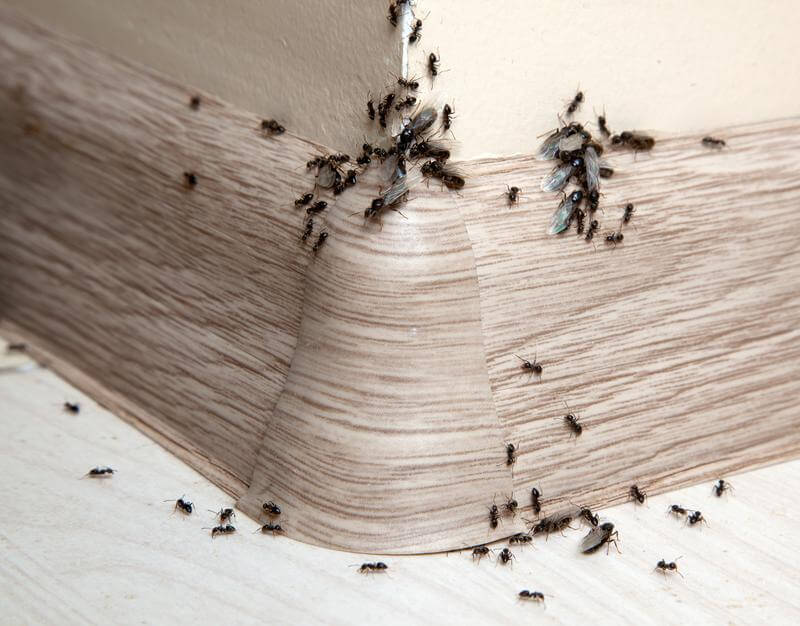Dealing with pest infestations at home can be a real hassle, but the first step to regaining control is knowing what signs to look out for. While some pests, like mice, leave behind unmistakable evidence, spotting an ant infestation can be trickier.
Whether you’re wondering if those innocent-looking garden mounds are harboring a colony of ants or seeking insight into the top signs of an ant problem, we’ve got you covered! Let’s delve into these subtle indicators and discuss practical strategies for prevention and management.
Signs of an Ant Problem
Identifying some of the cues of an ant invasion requires a keen eye. Here are seven common signs to watch for:
Presence of Ants
At first glance, spotting a few ants near your home might not set off alarm bells. After all, it’s easy to dismiss them as wayward stragglers hanging around indoors. However, it’s essential to take a closer look: are these ants wandering aimlessly, or are they following a specific path?

Ants often leave behind pheromone trails, signaling to their colony mates the location of a food source or a potential nesting site. If you notice ants marching purposefully toward your home or congregating around entry points, it’s a sign of an organized invasion that demands attention.
Sawdust Trails
Unlike termites that consume wood, carpenter ants excavate galleries within wooden structures to create nests, leaving behind sawdust-like frass and wood shavings.
Indoors or outdoors, keep a keen eye out for these sawdust trails, especially near wooden beams, flooring, or furniture. Carpenter ants are particularly drawn to damp or decaying wood, making areas prone to moisture, such as basements, attics, and crawl spaces, other prime targets for infestation.
Inspect wooden surfaces for these small piles of sawdust, and pay close attention to spots where wood meets potential entry points like window ledges, door frames, or utility openings.
Be mindful of any changes in the texture or appearance of wooden structures around your home. Carpenter ant infestations can weaken the integrity of wood over time, resulting in sagging floors, hollow-sounding beams, or visible damage.
Hollow Sounds
As carpenter ants excavate wooden structures, they can leave the wood hollow and unstable. You can often detect these hollow areas by tapping on wooden surfaces and hearing a hollow noise back.
Be thorough in examining wooden surfaces, tapping along beams, floors, and walls to identify any hollow-sounding areas. Take note of any changes in pitch or resonance, as these may indicate areas of significant ant activity.
Structural Damage
Carpenter ants can wreak havoc on wooden structures by carving out galleries to build their nests. Over time, this activity weakens the wood and makes it susceptible to damage and decay.
When inspecting your home, look for signs of deterioration, including soft spots, crumbling edges, or wood that gives way under minimal pressure. These are all signs of an ant problem and potential structural damage.
Be mindful of any changes in the appearance or functionality of wooden components. Difficulty opening or closing doors, sagging floors, or visible cracks in wooden beams are all signs of underlying structural issues that an ant infestation may cause.
Piles of Soil
Ant nests vary in size and shape, ranging from small mounds to extensive underground networks. They serve as the central hub of ant activity, housing the colony members and breeding grounds for new generations.
Inspect your lawn for these soil piles; however, if you notice signs of ants, approach the nest with care and avoid disturbing the nest. Take note of the mound’s location, size, and shape, as well as any visible ant trails leading to or from the nest.
Also, consider the location of the soil piles within your property. Ant nests are often found in moist soil, shaded areas, or near food, frequently popping up around gardens, backyards, and landscaping elements.
Discarded Wings
What causes flying ants in your house in the summer? Why exactly do you have ants in your home anyway?
During the summer months, ants undergo a “nuptial flight,” during which winged reproductive individuals, known as alates, leave the nest searching for mates and suitable locations to establish new colonies.

After mating, the males typically die, while the fertilized females shed their wings and seek out nesting sites to begin new colonies. Finding discarded wings in and around your home are clear signs of an ant problem and their nuptial flight.
Audible Rustling
As ants forage for food, expand their colonies, or seek new nesting sites, they may produce rustling sounds as they move through these confined spaces.
To hear these rustling noises, take a moment to listen closely to your walls, floors, or any area where you suspect ants reside. Focus on quiet moments, such as late at night or early in the morning, when ambient noise levels are minimal.
Preventing Ant Infestations with Natura
Taking proactive measures is vital to minimizing the risk of ant infestations in your home. By implementing the following strategies, you can create an environment that is less hospitable to ants and reduce the likelihood of them setting up camp in your home:
- Properly Dispose of Food Waste: Dispose of food scraps and keep leftovers in tightly sealed containers. Regularly empty your trash to prevent odors and food residue that may attract ants.
- Clean-up Spills: Spilled food and beverages can entice ants to invade. Promptly clean spills to remove a potential ant food source.
- Wash Dirty Dishes and Utensils: Dirty dishes left in the sink can attract ants looking for food residue; wash them soon after use to remove lingering food particles.
- Seal Gaps and Cracks: Seal gaps around windows, doors, and other entry points with weatherstripping or caulk to prevent ants from gaining access to your home.
- Elevate Firewood: Keep firewood stored off the ground and away from the exterior walls of your home to reduce the likelihood of ants nesting in the woodpile and migrating into your home.
- Prune Dead Trees and Bushes: Dead or decaying tree limbs can serve as prime nesting sites for ants. To minimize the risk of ant infestations, regularly prune trees and bushes and remove dead limbs on your lawn.
But what are your best options for long-lasting treatment against an ant infestation in your house or property? The experts here at Natura.
Spotting the signs of an problem isn’t always easy, but our trained technicians can quickly locate and eliminate these pests. Don’t let a minor nuisance escalate into a costly problem—take proactive steps to safeguard your home today.
When you’re struggling with house ant problems, give us a call!



